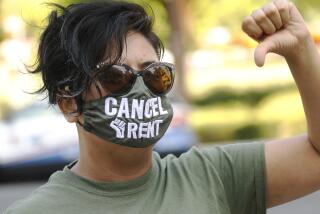Despite Supreme Court Ruling, Many Fear Filing Suit : Victims of Sexual Harassment Face Long Fight
WASHINGTON — Betsy Swentek finds herself in a peculiar position these days. A flight attendant for USAir, she is uneasy about talking to the pilots on planes she flies--because, she claims, they are likely to greet her with lewd comments and obscene gestures.
“It’s an awful way to live,” said Swentek, who is awaiting the outcome of the sexual harassment charges she filed against a pilot last year. “All I want to be able to do is work.”
Women’s rights groups say that Swentek and other women battling sexual harassment still have a long fight ahead of them despite a ruling by the Supreme Court in June that such practices in the workplace violate the 1964 Civil Rights Act because they discriminate against women.
Character Often Attacked
“The Supreme Court decision is not going to open the door for a lot of women,” said Francine Weiss, a sex discrimination attorney in Washington. She said many victims of sexual harassment will continue to keep their complaints to themselves because the Supreme Court, by not barring from trials such evidence as the victim’s provocative dress and sexual fantasies, still allows sexual harassment trials to turn into attacks on the victim’s character.
“We do not allow that type of evidence in rape cases,” said Gloria Allred, an outspoken Los Angeles attorney who specializes in civil rights cases, “and I don’t think we should allow that kind of evidence in sexual harassment cases either.”
Yet employers have their own grievances with the Supreme Court ruling. Without precisely defining the circumstances, the court said that management may be held liable for employee sexual harassment of which it is not aware.
“There is a tremendous feeling in the workplace . . . that anything (employers) do, they’re liable to be sued,” said Stephen A. Bokat, vice president and general counsel of the U.S. Chamber of Commerce. What appears to be innocent behavior on the part of one of its employees, he said, can become the basis of a sexual harassment charge in which the company is among the accused.
The Civil Rights Act defines unwelcome sexual advances as harassment when submitting to them becomes a condition of the victim’s job or interferes with doing a job. The Supreme Court, in a case involving a Washington bank assistant branch manager, held that a “hostile working environment”--ranging from dirty jokes to assault--in itself constitutes illegal sexual harassment even if the victim suffered no economic injury.
7,273 Cases Reported
Even before the Supreme Court ruling, sexual harassment cases had been mounting steadily at the Equal Employment Opportunity Commission, which enforces the civil rights law. The EEOC said it received an all-time high of 7,273 complaints in the last fiscal year, up from 6,342 the year before.
And women’s rights advocates say that for every woman who goes to the EEOC, many others remain silent or work out their complaints with their employers without seeking redress from the government. “The statistics from the EEOC don’t begin to indicate the size of the problem,” Allred said.
The National Organization for Women cites studies claiming that at least 50% of all women working outside the home experience sexual harassment on the job, which NOW defined as anything from obscene pictures on the wall to actual sexual advances.
One of the broadest surveys of sexual harassment in the workplace was a 1980 study of federal workers by the government’s Merit Systems Protection Board, which concluded that 42% of 294,000 female federal employees had been sexually harassed in the workplace.
Claudia Withers, director of employment programs at the Women’s Legal Defense Fund, said harassment is the third most common form of sex discrimination reported to her office, after hiring discrimination and unfair treatment of pregnant workers.
Complaints Run the Gamut
Women in all lines of work, from secretaries to construction workers, are victimized, she said. Their complaints, she added, “run the gamut from comments to leers to attempts to rape on the job.”
Women who file charges frequently complain later that their employers retaliate against them with increased harassment or even dismissal.
Retaliation is also illegal under the Civil Rights Act. But Bokat of the Chamber of Commerce said what appears to the employee to be retaliation is often nothing more than a case in which management has consistently judged the employee’s performance to be unsatisfactory.
Swentek says she is a prime example of a woman who faced more persecution as a result of filing charges. Other pilots have verbally harassed her, she has been physically threatened and her mail has been destroyed, she says.
“When you speak up about it, you get it even more,” she said. “People at work who were friendly with me . . . suddenly became very cold. It was as if I had committed a terrible crime.”
Dismissed as ‘Bad Manners’
Nor has she had much luck in court. Her first federal court jury awarded her $20,000 in damages for emotional distress--not enough to cover legal costs--but the judge disagreed with the award and ordered a new trial. The second judge dismissed the case as an episode of nothing more than “bad manners”; Swentek has taken that decision to a federal appeals court.
In going ahead with a trial, Swentek was an exception. Once charges are filed, both sides typically find it to their advantage to reach a settlement.
Eric Joss, a Los Angeles attorney who has represented employers in sexual harassment cases, said: “Virtually everyone in that jury box identifies with the plaintiff because everyone in that box holds a job of one kind or another.”
In late 1984, a civil court jury ordered the president of a Torrance computer firm to pay $975,000--one of the largest such awards ever--to a woman who claimed the man sexually assaulted her. The widely publicized lawsuit between the American Broadcasting Co. and Cecily Coleman, former director of ABC’s voter-education program, was settled in 1985 for $500,000.
From the employee’s point of view, harassment cases “are incredibly nasty to litigate,” said Washington attorney Jane Dolkart. “The victim starts to feel like (she is) still the victim.”
‘It Was Torturous’
Swentek said she testified for eight hours during her first trial and for four hours during a retrial, in addition to giving almost 34 hours of deposition. “It was torturous to sit there and be questioned over and over again,” she said. “Things were brought out of my personnel files that had no relation whatsoever” to the case. “I immediately became the defendant.”
For such reasons, many women avoid the courts. An insurance company employee, who asked not to be identified, said she began internal grievance procedures against a supervisor who bragged about his sexual conquests and “acted like a tyrant” toward women, but she decided to drop the action before going to court.
Medical problems caused by stress weighed heavily in her decision, said the woman, who was 55 at the time of the harassment. Besides, she added, “it looked like I couldn’t get a decent job” outside the company with benefits comparable to those accumulated over seven years.
Instead, she accepted a transfer from her administrative position to a secretarial job in another department. But she now regrets dropping the grievance because her former supervisor harassed the two women who followed her in her old job.
Women’s groups agree that until such victims lodge charges, harassment in the workplace will continue.
More to Read
Inside the business of entertainment
The Wide Shot brings you news, analysis and insights on everything from streaming wars to production — and what it all means for the future.
You may occasionally receive promotional content from the Los Angeles Times.










